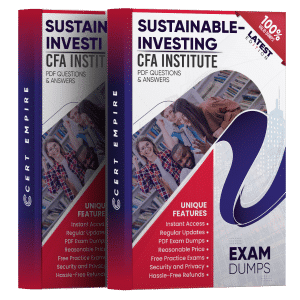CFA Institute Sustainable-Investing Exam Questions 2025
Get exam-ready for the CFA Institute Certificate in ESG and Sustainable Investing using our up-to-date Exam Questions. Reviewed by finance and ESG professionals and supported with precise answers and an online simulator, they make your preparation smooth and effective.
What Users Are Saying:
About Sustainable-Investing Exam
Introduction of Sustainable-Investing Certification
As firms around the world get serious about environmental and social impact, the CFA Institute’s Sustainable-Investing Certificate (CFA-SIC) has emerged as a trusted name. It’s built for professionals who want to sharpen their knowledge of ESG-focused strategies without going through an entire CFA charter. Whether you’re in asset management, research, compliance, or corporate governance, this cert shows you understand how sustainability factors into modern financial decisions.
More importantly, this certification isn’t limited to analysts. Advisors, risk officers, consultants, and even policy workers are now part of the growing audience. The CFA-SIC continues to evolve with increasing regulations, pushing many firms to make ESG training a core requirement. Getting certified in this space means keeping pace with both market expectations and global accountability standards.
What CFA-SIC Offers That Typical Finance Courses Don’t
The CFA-SIC is built to show that you can apply ESG frameworks to real scenarios. It focuses less on textbook finance theory and more on how to apply environment, social, and governance filters to financial decisions. Candidates get hands-on knowledge of climate-related risks, sustainability disclosures, materiality assessments, and long-term value creation beyond basic returns.
Another reason professionals pick this cert is the independent credentialing power of the CFA Institute. Its reputation globally makes the certificate useful for building credibility in front of senior decision-makers or hiring teams focused on ESG skill gaps.
Who This Certificate Suits and What You Should Already Know
If you’ve already got some foundation in capital markets or work in a field adjacent to finance, this is for you. That said, candidates from tech, energy, government, and non-profit backgrounds are also increasingly signing up. While there are no strict prerequisites, familiarity with financial instruments, data analytics, or basic risk frameworks will give you an edge.
The program helps individuals make sense of how ESG influences asset pricing, stewardship, and capital allocation. Most candidates take it for career development, team compliance mandates, or personal interest in responsible practices.
The Rise in Employer Demand for Sustainability Credentials
You’re not just doing this for personal growth. Hiring managers across private equity, banking, consulting, and even insurance now flag ESG credentials as valuable. Many firms include sustainability training in onboarding, and this cert offers a third-party proof that saves them training time.
Some companies are now tying ESG knowledge to bonus benchmarks or promotion tracks, especially in the EU and APAC regions. The CFA-SIC fits well in a résumé section where you’re showing technical and ethical competence.
Topics That Come Up Again and Again on the Exam
The CFA-SIC syllabus revolves around practical ESG integration. You’ll study the use of ESG data, climate scenario planning, fiduciary responsibility, corporate engagement, and regulatory disclosures. Expect coverage of standards like SASB, GRI, UNPRI, TCFD, and frameworks used in corporate stewardship.
The course also dives into understanding greenwashing, materiality mapping, and aligning sustainable metrics with enterprise value. You’ll need to understand real frameworks and how they’re applied not just memorize acronyms.
What Format the CFA-SIC Exam Follows
The CFA-SIC Test is a timed online exam, completed remotely with a secure browser. It consists of multiple-choice and scenario-based questions. The average completion time is around 2 hours. It’s open to candidates worldwide, and many complete it at home or at their workplace under proctored conditions.
The questions test your ability to apply ESG concepts not just recall facts. Each scenario will usually include a real-world example, asking what action or framework would apply.
Study Strategies That Work Well for This Exam
There’s no point in going broad and unfocused. Instead, professionals succeed by creating a 4–6 week plan that emphasizes concept-to-practice learning. Since many candidates already work full-time, they focus on using condensed summaries and practical question sets over long readings.
Some strategies that help:
- Use real frameworks in practice scenarios
- Review CFA Institute examples and guidance papers
- Set weekly topic targets to avoid burnout
- Use visual summaries and ESG data charts to retain information
Salary Impact and Career Leverage Post-Certification
Completing the CFA-SIC can open up mid-career or lateral roles in sustainability analytics, advisory, or reporting. For those already in finance, it boosts credibility in ESG reporting or stewardship roles. The CFA-SIC Salary reports vary, but candidates have seen increases of 10%–18% within 12 months post-cert in mid-tier firms.
Professionals in boutique advisory roles or ESG-focused funds report a particularly high ROI, especially when paired with other financial certs or climate-specific courses.
2 reviews for CFA Institute Sustainable-Investing Exam Questions 2025
Discussions
There are no discussions yet.



Wyatt Moreno (verified owner) –
The Sustainable-Investing exam was interesting but demanding. I relied on study material and practice tests to guide me through the preparation, and it made passing the exam much smoother.
Selena Martin (verified owner) –
The study files included a simulator that mirrored actual exam conditions. It was a helpful addition that made practicing under timed settings easier.